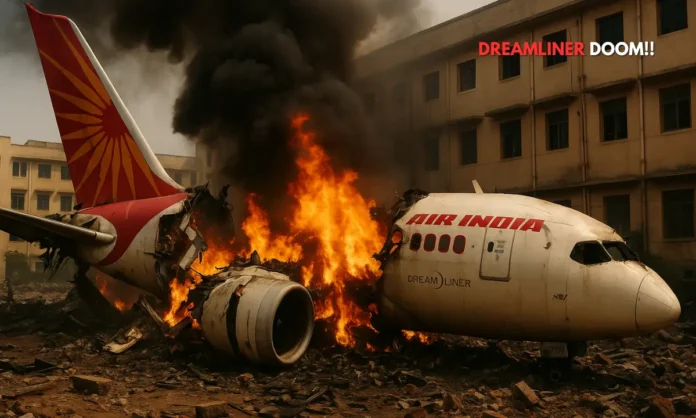SUMMARY
- Over 240 dead as Air India’s Boeing 787-8 crashes into Ahmedabad medical campus moments after takeoff.
- Investigations launched by India’s AAIB and US NTSB; cockpit voice recorder and flight data recovered.
- DGCA orders urgent safety reviews of Air India’s Dreamliner fleet amid international pressure.
Aftermath in Ahmedabad: How a Routine Flight Became India’s Deadliest Civil Aviation Disaster Since 1996
Thursday’s horrifying crash of Air India’s Boeing 787-8 Dreamliner has ignited one of the most intense aviation investigations in India’s history. Bound for London with 242 people on board, the aircraft disintegrated into the BJ Medical College complex mere seconds after takeoff, killing all but one passenger and at least 30 on the ground.
While the airline confirmed that the aircraft, registered VT-ANB, had undergone its last comprehensive “C” check in June 2023, its sudden nosedive stunned aviation experts, many of whom are now raising critical questions about Boeing’s Dreamliner series amid a growing list of international safety incidents.
Boeing engineers have landed in Ahmedabad to work alongside India’s Aircraft Accident Investigation Bureau (AAIB), while the US National Transportation Safety Board (NTSB) is conducting a parallel inquiry under ICAO international protocol.
The incident marks the first-ever fatal crash involving a Boeing 787-8 and comes at a time when Boeing is already facing mounting scrutiny globally, from the Alaska Airlines door panel blowout to whistleblower allegations over manufacturing flaws. The stakes could not be higher—for Air India, for Boeing, and for international confidence in long-haul commercial aviation.
Boeing team visits crash site for on-ground assessment
— CNBC-TV18 (@CNBCTV18News) June 15, 2025
The aircraft maker's experts spent over two hours examining the wreckage from multiple angles. While the probe is led by DGCA and AAIB, Boeing may offer technical support to aid the investigation.#Boeing #AirIndiaCrash… pic.twitter.com/JHYZ4F1FiZ
Disaster at Takeoff: Survivors, Wreckage, and Initial Clues
- The plane struck the roof of a doctors’ hostel, exploding on impact.
- Only one passenger, seated in 11A, survived—his testimony may prove crucial.
- Both the flight data recorder and cockpit voice recorder have been recovered.
Initial reports reveal that the aircraft barely gained altitude before veering off course and plummeting into the heart of the BJ Medical College campus. The location—dense with buildings and people—turned a mechanical failure into a mass casualty event.
The cockpit voice recorder, recovered late Sunday, may help investigators reconstruct the final seconds of the flight. According to aviation ministry officials, the black box (FDR) was found lodged in the rooftop debris, recording critical data such as engine performance, altitude, and pilot inputs.
This data will be cross-examined with air traffic control logs and eyewitness accounts—including the lone survivor, a 27-year-old businessman who claims the aircraft made a sharp tilt before impact. His account, while unverified, aligns with radar tracking anomalies that showed an abnormal climb rate moments before the crash.
Safety Crisis or Isolated Tragedy? What Experts Say
- DGCA orders immediate inspections of all 787-8 and 787-9 aircraft in India.
- Aviation insiders question whether design flaws may be to blame.
- Global scrutiny intensifies around Boeing amid geopolitical travel concerns.
The Directorate General of Civil Aviation (DGCA) has responded by mandating enhanced safety audits of Air India’s entire Dreamliner fleet, which includes 26 787-8s and 7 newer 787-9s. This follows months of escalating concern over Boeing’s quality control, following congressional hearings and lawsuits in the US.
Although Air India initially pointed to the aircraft’s scheduled maintenance compliance, many experts argue that software glitches, structural fatigue, or engine anomalies could have been missed during standard inspections. “We may be looking at a latent defect triggered under extreme conditions,” said an aviation consultant briefed on the probe.
Meanwhile, international carriers operating Boeing 787s have begun internal safety assessments. Lufthansa, ANA, and Qatar Airways have all requested additional engine telemetry reviews. The incident’s timing, amid the ongoing Israel-Iran airspace crisis, has further strained confidence in long-haul international routes across Eurasia.
Travel advisories have already been updated by several governments, and insurance premiums for Dreamliner fleets are reportedly being re-evaluated.
Turbulence Ahead: What the Ahmedabad Tragedy Means for Boeing—and India
This crash is more than a singular aviation tragedy. It is a flashpoint in a broader debate about Boeing’s manufacturing integrity, global oversight gaps, and India’s aviation safety ecosystem. For Air India, which is rebranding under Tata Group ownership with an ambitious fleet modernization plan, the timing is brutal.
If Boeing is found liable for any technical lapse—mechanical or digital—the economic and reputational fallout could reshape the wide-body jet market for years to come. With Airbus eyeing expansion into Asia and Russia’s Irkut MC-21 slowly gaining ground, Boeing cannot afford another crisis of confidence.
India, too, must reckon with its regulatory rigor. As the country rapidly scales its aviation infrastructure, from new regional airports to digital air traffic management, incidents like this raise questions about the preparedness of ground response teams and pilot training programs.
The AAIB and NTSB reports, expected in preliminary form within weeks, could determine not just compensation for victims, but the trajectory of India’s global aviation partnerships. What’s clear is this: the sky may never be the same again for Boeing—or for those who fly under its wings.


